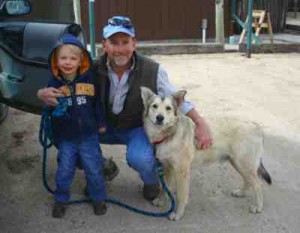Column by John Mattingly
Agriculture – June 2008 – Colorado Central Magazine
DATELINE: DENVER, COLORADO MAY 3, 2034
In a joint news conference yesterday, Steady State Bank, Resurrection Mortgage, and Overburtin Industries announced plans to plow under another 160 acre subdivision in Thornton and plant wheat.
“We can’t sell or rent these OREO (other real estate owned) units,” said Jennifer Long, president of Steady State. “Between our institution and Resurrection, we held all but a couple of the mortgages in this particular subdivision, which has been vacant for over two years. With the price of wheat at nearly $450 a bushel, and 300 bushel per acre yield potential, it didn’t take a computer to figure our best option. We contacted Overburtin and were pleased to learn about their new plowing unit. Hank Stram, CEO of Overburtin, the company that developed both the commercial and the residential moldboard plow, displayed the new plow, the OT-17xi, capable of plowing under 50 homes a day, and said the new unit would be operational for the Thornton job.
“In the past, we’ve been limited by two factors,” Stram said. “First, the bio-gester compound we sprayed on the homes to initiate decomposition, acted unevenly on plastics, metal, carbon, and concrete. And the blend was slow to act, taking up to a week to incubate the unconducted materials found in homes and neutralize all toxins. Our new blend contains nanobots capable of targeting and digesting specific compound arrays with the precision of a dentist drilling out a cavity. We call it Intelligent Destruction, and it’s fast, prepping the homes for plowdown within 24 hours.
“Our second limitation was the trashboard design on our prior OT-13x Model which failed to bury aberrant roofing material of the larger, sprawling homes. By altering the angle of repose for the trashboard mount, and placing laser sensors at the edge, we’re able to follow the contour of the subdivision roofline and bury it all without a trace between 200 and 220 feet deep. Further, we incorporated new landslide modifications at the base of the moldboard itself, used virtually indestructible alloys on the impact shins, and added larger heels and frogs, a gang of modifications that leave the ground free of all residential debris, and basically ready to plant.” When asked if Overburtin had plans to integrate plowing and planting operations, Stram indicated his engineers were losing sleep over that one.
“At this point, we at Overburtin are sticking to our policy decision, which is to do as much as we can. We’re always looking for ways to combine operations and kill two stones with the same bird. Farmers tell us that it’s better to do one thing at a time and do it well, and we’ve listened to them; we’re working on every conceivable angle. You folks have to remember, we’re pulling a 6-bottom moldboard plow and each moldboard spans 268 feet. We’re taking homes, full of unconsolidated debris, and turning them under, bringing up good dirt for crops. If something goes wrong with the planting leg of the task, it stops the plows, and vice- versa, so the real problem is to make the integrated machine totally reliable. We’ll get there. Be patient. And don’t forget, safety is crucial. Our plows have multiple scanners with built-in heat and motion detectors to be sure we don’t plow under a dog or a coyote hiding in the abandoned units. Initially we tried to save prairie dogs and gophers, but recent Supreme Court rulings have allowed us to go ahead and put them down with the rest of the debris.”
Overburtin’s entry into the plowdown business began in 2031 when they developed the OT-5z, a single moldboard capable of turning under multi-story commercial buildings. Overburtin proved their superiority in the market when they successfully plowed under the Denver Tech Center, now one of the state’s most productive vegetable farms, employing over 100,000 people.
When asked if Overburtin had plans to develop a plow capable of turning under skyscrapers, Stram waxed philosophical, “Listen, we’re sensitive to the fact that people have to live somewhere, and high rise structures with shared and concentrated facilities provide the most efficient and sensible way to go about it. So we see that as a surviving trend. Along with the fact that people have to eat.
“Back in the 20th Century,” Stram continued, “people obviously got carried away, strutting their balance sheets and tricking up their homes to where it was like Marie Antoinette telling the starving peasants to eat cake. Let us remember that most species have a natural limit on their population vis-a-vis food supply. Humans have tried to do an end-run around that one ever since they invented farming. When food was cheap, people threw their money at houses. Now that food is expensive, they can’t do that anymore. Some of the space given to homes has to go back to food. That’s where we at Overburtin come in. We’ve plowed under almost 50,000 acres of residential housing and over 415,000 acres of commercial buildings in the last three years in the United States, and several multiples of those acreage numbers worldwide, all of which has helped humanity continue to eat.”
John Mattingly is a recovering San Luis Valley farmer.


